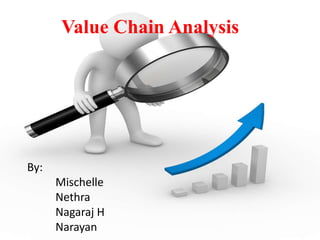
Value chain analysis
- 1. Value Chain Analysis Presented By: Narayan Gaonkar
- 2. Introduction: The idea of a value chain was first suggested by Michael Porter (1985) to depict how customer value accumulates along a chain of activities that lead to an end product or service. Porter describes the value chain as the internal processes or an activity a company performs “to design, produce, market, deliver and support its product.”
- 3. Definition: “Value chain analysis (VCA) is a process where a firm identifies its primary and support activities that add value to its final product and then analyse these activities to reduce costs or increase differentiation.” “Value chain represents the internal activities a firm engages in when transforming inputs into outputs.”
- 4. The value chain contains two types of activities: Primary activities : Where most of the value for customers is created. Support activities: That facilitate performance of the primary activities
- 6. Primary Activities: • Inbound logistics: Material handling and warehousing. • Operations: Transforming inputs into the final product. • Outbound logistics: Order processing and distribution. • Marketing and sales: Communication, pricing and channel management • Service: Installation, repair and parts.
- 7. Support activities ● Procurement: Purchasing of raw materials, supplies and other consumable items as well as assets. ● Technology development: Know-how, procedures and technological inputs needed in every value chain activity. ● Human resource management: Selection, promotion and placement, appraisal, rewards management development and labour or employee relations. ● Firm infrastructure: General management, planning, finance, accounting, legal, government affairs and quality management.
- 8. Objective value chain analysis: The objective is to analyse competitive advantage by disintegrating an organisation into discrete activities or processes and examine how each activity contributes to the organisation’s relative cost position or the customer’s comparative willingness to pay.
- 9. Value Chain Activities for a Hotel Chain Primary Activities • Site selection and construction • Reservations • Operation of hotel properties • Managing lineup of hotel locations Support Activities • Accounting • Hiring and training • Advertising • Building a brand and reputation • General administration
- 10. Cost Advantage and the Value Chain: A firm may create a cost advantage either by reducing the cost of individual value chain activities or by reconfiguring the value chain. It include, Economies of scale Learning Capacity utilization Linkages among activities Interrelationships among business units Degree of vertical integration Timing of market entry Firm's policy of cost or differentiation Geographic location Institutional factors (regulation, union activity, taxes, etc.)
- 11. Differentiation and the Value Chain: A differentiation advantage can arise from any part of the value chain. It may, Policies and decisions Linkages among activities Timing Location Interrelationships Learning Integration Scale (e.g. better service as a result of large scale) Institutional factors Many of these also serve as cost drivers. Differentiation often results in greater costs, resulting in trade-offs between cost and differentiation
- 12. Example: Value Chain Activities Computer Software Industry Programming Disk loading Marketing Distribution
- 13. Limitations of Value Chain Analysis : Difficulty in implementation and interpretation Problem of Traditional Accounting system Difficulty in decision making
